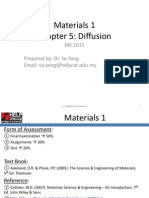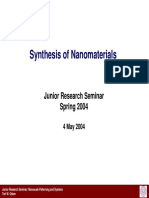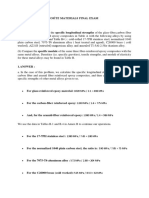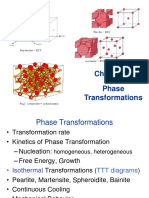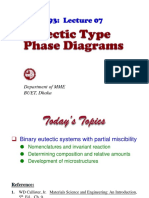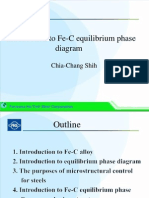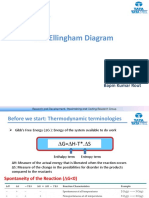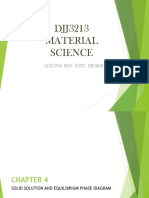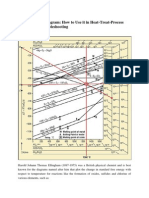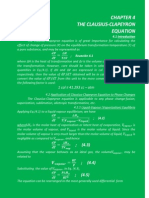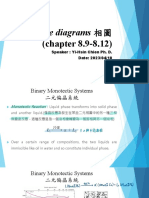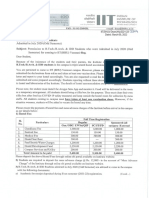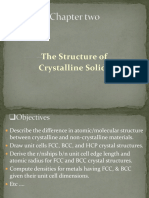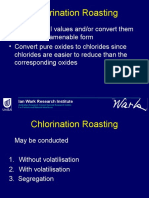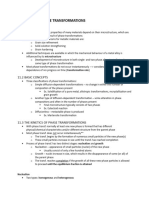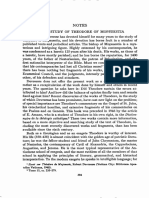Midterm Exam
MET246E
Materials Physics • 2 June 2021 Wednesday 13:30
Kinetics of Phase Transformations:
Nucleation & Growth
Prof. Dr. Hüseyin Kızıl
Department of Metallurgical and Materials
Engineering
1 2
Northeastern University Northeastern University
Thermodynamics of Phase Transformation Kinetics of Phase Transformation
For phase transformations (constant T & P) relative stability of the system Phase transformations in metals/alloys occur by
is defined by its Gibb’s free energy (G) nucleation and growth
Gibbs free energy is a thermodynamic potential • phase transformation from B to A • Nucleation: New phase (β) appears at certain sites within the metastable parent
that measures the "useful" or “process-initiating” G (α) phase.
work obtainable from a thermodynamic system
at a constant temperature (T) and pressure (P) ΔGa • Homogeneous Nucleation: Occurs spontaneously & randomly without
dG=0 preferential nucleation site.
dG=0 • Heterogeneous Nucleation: Occurs at preferential sites such as grain
• Gibb’s free energy of a system:
ΔG boundaries, dislocations or impurities.
• G = H-TS • Growth: Nuclei grows into the surrounding matrix.
B Activated State A
• Criterion for stability:
• dG = 0 Criterion for phase transformation:
ΔG= GA- GB < 0 SOLID
à GA< GB 2 3
LIQUID
How fast does the phase transformation occur ?
Example: Solidification: L S
3 4
1
� Driving force for solidification Northeastern University
Driving force for solidification undercooling to ΔT, ΔG > 0
q During the cooling of a liquid, solidification (nucleation) will
begin only after the temperature has been lowered below the
Example: Solidification, L S
equilibrium solidification (or melting) temperature Tm
• At a temperature T :
This phenomenon is termed supercooling (undercooling) Driving Force for
• GL= HL- TSL; GS= HS- TSS solidification
Free energy (G)
• ΔG = GL– GS =ΔH – TΔS ΔG
q The driving force to nucleate increases as DT increases
• At the equilibrium melting point, Tm :
• ΔG = ΔH – TmΔS = 0
GS
q Small supercooling à slow nucleation rate - few nuclei - large • ΔH = L (Latent heat of fusion)
crystals ΔT GL
• For small undercoolings (ΔT):
• ΔG ≈ L ΔT/Tm > 0
q Large supercooling à rapid nucleation rate - many nuclei - T TM Temperature
small crystals
Decrease in free energy (ΔG) provides the driving force for solidification
5 6
Homogeneous Nucleation ΔGhom for a given undercooling (ΔT)
(Undercooling = Supercooling)
• Difference in free energy:
G2= VsGs+VLGL+AγSL Surface(interfacial)
• ΔG hom = G 2– G 1 =V S(G S – G L) + Aγ SL at r=r*
G1= VsGL+VLGL energy addition
r*
• For a spherical particle:
• ΔG hom = G 2– G 1
ΔG*hom
SOLID
LIQUID
Both r* and ΔG* depend on
LIQUID Volume energy
GL undercooling (ΔT). reduction
Volume Interfacial G1 G2 GS’
free energy energy r=r*
GS
G1< G2
• Volume free energy increases with – r3
r= ∞
• Surface (Interfacial) free energy increases with r2 addi$onal interface created between the A nucleus is only stable if further growth
solid par$cle and the surrounding liquid ΔT
reduces the energy of the system.
For r > r* the nucleus is stable
T TM 6
7 8
2
� Northeastern University Degree of Undercooling for Homogeneous Nucleation
Critical Undercooling for Nucleation TN
Homogeneous nucleation occurs only
when liquid is undercooled by TN
TN = ΔT = T-Tm
at T=Tm , TN=0
TN
Melting
point Critical undercooling for nucleation 7
TN = ΔT = 0
9 10
Northeastern University Example problem: critical radius and
Rate of Homogeneous Nucleation, Nhom activation energy for nucleation
• For a given undercooling: [clusters/m3]
C0 : Atoms per unit volume in the liquid. A) If pure liquid gold is cooled to 230 oC below its melting point,
C*: Number of nuclei that reached critical size. calculate the critical radius and the activation energy (ΔG*). Values for
• Addition of one more atom, converts the clusters to a stable nuclei. the latent heat of fusion (L) and surface free energy are -1.16x109 J/m3
• If this happens with a frequency of fo Nuclei /m3s and 0.132 J/m2, respectively. (Tm =1064oC)
N
Nuclei /m3s B) Calculate the number of nuclei of this critical size.
a)
b)
ΔT
TN
No nuclei is formed until TN is reached !! 8
11 12
3
� Northeastern University
Wetting angles
Heterogeneous Nucleation
In practice, homogeneous nucleation is rarely observed
Sources of heterogeneous nucleation sites:
• Dislocations
• Grain boundaries
• Secondary phase particles
• Mold walls &cracks
• Dust particles
ΔGhet = V(GS – GL) + ASLγSL+ ASMγSM - ASMγML
= ƒ(θ)
= ΔG hom.ƒ(θ)
f(θ) : the frequency factor
9
ƒ(θ) ≤ 1 is a function of the wetting angle
13 14
Northeastern University Northeastern University
ΔGhet for a given undercooling (ΔT) Variation of ΔG* & nucleation rates with ΔT
ΔG Smaller undercooling is required for heterogeneous nucleation
ΔG*hom
Nuclei / m3s
ΔG*het
f(θ) = r f1 or f (θ) is the frequency factor
f(θ)
r* ΔGhet C 1 is the # of atoms in contact with the heterogeneous
nucleation sites.
Note: ΔGhom
• r* depends only on ΔT.
• ΔGhet* depends on f (θ) and ΔT
• ΔGhet*< ΔG*hom
10 11
15 16
4
� Northeastern University
Transformation types
Avrami Model for Growth: Fraction Transformed
Assumptions:
Continuous nucleation:
more nuclei added
• Nucleation occurs randomly and homogeneously
during transformation.
• Growth rate does not depend on the percent of transformation
• Growth occurs at the same rate in all directions
Nuclei
Site Saturated:
all nuclei present at t = 0 Parent phase
Cellular recrystallization: Kinetics same as
for site saturated case. New secondary
phase
12
17 18
Avrami Model: Rate of Phase Transformation
Avrami Model: Derivation
Fraction transformed, f
transformation complete
Fixed T
0.5 maximum rate reached – now amount
unconverted decreases so rate slows
NOTE: , G’ & N’ are the growth and nucleation rates
rate increases as surface area increases
n = 4 ……… when growth is 3-D & N’ is constant t0.5 & nuclei grow
n = 3 ……… when growth is 3-D & nuclei are preformed
n = 1,2 …… when growth is restricted in 1-D (surface) or 2 D (edge)
log t
KJMA equation => f = 1- exp (-kt n)
fraction
transformed
Rate of transformation = 1 / t0.5
2-D growth along a stepped interface
13
Rate of transformation is defined as the inverse of the time to complete half of the
transformation. This describes most solid-state transformations that involve diffusion.
19 20
5
� Example problem: Fraction transformed
Example problem: Fraction transformed
f = 1- exp (-kt n)
The kinetics of the austenite to [ferrite + Fe3C] (pearlite) transformation is found
to obey the Avrami relationship. Using the fraction of austenite transformed
versus time data given below for a certain isothermal treatment below the
eutectoid temperature, determine the total time required for 95% of the
austenite to transform to pearlite.
For f = 0.95,
Make a plot of the fraction transformed as a function of the log(t) for this f = 1- exp (-kt n) à t = 36.4 s
process.
21 22
Example: Effect of strain on re-crystallization
Example problem: Fraction transformed
f = 1- exp (-kt n)
23 24




